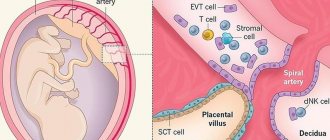Movies often depict how the pregnant heroine suddenly bursts out with amniotic fluid. After which the birth itself inevitably begins. Reality is often not so epic, and everything is not so fleeting. For some expectant mothers, water rather flows slowly and in a thin stream, and labor begins only after some time. Here we will tell you about how your water breaks and what happens next. There is definitely no need to panic - your doctor will also tell you how this happens and what follows.
Amniotic fluid: what happens when it breaks
During pregnancy, the fetus is surrounded by amniotic fluid in the amniotic sac, which protects it from external factors. Amniotic fluid promotes the development of the baby's lungs and gastrointestinal tract, and also maintains a constant temperature. During the second half of pregnancy, amniotic fluid consists primarily of the baby's urine, but it also contains nutrients, hormones and antibodies that help fight infections. At the beginning of contractions or during them, and sometimes before the onset of contractions, the membranes of the membranes rupture. This stage of labor is referred to as “the water has broken.” Often this is how the onset of labor manifests itself at an early stage. Doctors do not know what exactly causes the bladder to rupture.
Complete rupture of water: signs
The most important sign of water breaking is the release of a large amount of fluid from the perineum.
Some women clearly feel cotton inside the abdomen, which is accompanied by further leakage of water. In rare cases, there may be a nagging, paroxysmal pain in the lower abdomen. First, the so-called “anterior” fluid is discharged, thanks to which the baby begins to move along the birth canal. For some women, the bladder ruptures while taking a shower. After the amniotic fluid is released, the contractions intensify and the woman enters the second stage of labor.
How the water breaks: sensations
All expectant mothers' water breaks differently. Even if you already have children, this time may be different. The sensations may be different: water may flow in a thin stream or flow out in a sharp stream. Sometimes a faint pop is felt, and sometimes the liquid comes out in portions when changing position. The way the water drains is influenced, for example, by the position of the baby's head, which closes the cervix like a plug. When the head moves, fluid comes out. Also, water leaks during contractions, and this process continues until the baby is born. If your water begins to break and you are going to the hospital by car, take with you an absorbent diaper or towel to sit on.
As a rule, amniotic fluid is clear or pale yellow in color and odorless. The most fluid accumulates inside the bladder by the 36th week of pregnancy - about 950 milliliters, and then the water level gradually decreases.
How do you know if your water has broken? Sometimes it may not be clear whether your water has broken, or, for example, you are simply leaking urine (when you feel an occasional thin stream or your laundry gets wet). There is no need to be tormented by doubts; consult your supervising doctor. You can determine whether your water has broken during an examination or with the help of an ultrasound.
Harbingers of childbirth
The harbingers of childbirth are those “news” that the body sends us so that the expectant mother understands that the long-awaited meeting is approaching.
It is impossible to know the day “X” in advance, since these signs can appear both a few hours and several weeks before the start of regular labor.
But, the closer the date of birth, the more carefully the expectant mother should listen to the sensations in her body.
In the last weeks of pregnancy, the hormonal levels of the expectant mother change. As the placenta ages, the production of the pregnancy hormone progesterone decreases and the level of estrogen increases, under the influence of which the pregnant woman’s body prepares for the upcoming birth.
In the cerebral cortex, the center of labor is formed - the dominant of labor.
The appearance of precursors of labor is a normal reaction of the body to changes in hormonal levels, which does not require any correction. For some women, the body’s preparation occurs unnoticed, and this is also absolutely normal.
Precursors of childbirth include such signs as:
- prolapse of the abdomen;
- weight loss;
- discharge of the mucus plug;
- discomfort in the lower abdomen and back;
- change in appetite;
- emotional instability;
- training contractions.
Let's look at each sign in more detail.
1. Abdominal prolapse
In 10-14 days, the fetus takes the most convenient position for childbirth - the presenting part of the fetus is pressed against the entrance to the pelvis, so the fundus of the uterus moves down. The pressure on the diaphragm and stomach is reduced, it becomes easier for the expectant mother to breathe, heartburn and the feeling of heaviness after eating disappear. However, moving lower, the uterus puts pressure on the bladder and rectum, so urination and stool become noticeably more frequent.
2. Losing body weight.
During pregnancy, the main hormone is progesterone, one of its actions is to retain fluid in the tissues. On the eve of childbirth, when its level decreases and the level of estrogen in the blood increases, excess fluid is removed from the body of a pregnant woman. This explains the weight loss.
3. Removal of the mucus plug.
A mucus plug is a thick mucus that fills the cervical canal during pregnancy and serves as a barrier to any infection entering the baby. The release of the mucus plug usually occurs 1-2 days before the onset of labor, although it may take two to three weeks.
On the eve of childbirth, the cervix begins to change: it softens, shortens, centers (is located in the center) and opens slightly. As a result, the mucus plug comes out.
Some women may notice a plug in their underwear (a lump of dense mucus, colored brown or with a small admixture of blood), and some pregnant women do not notice this process at all, since their mucus plug can only come out during the birth of the child.
The release of the mucus plug is the most significant sign in terms of information content.
4. Discomfort in the lower abdomen and back.
Discomfort in the lower back (sacrum) and lower abdomen can be caused by sprained ligaments and increased blood flow to the pelvic organs. These sensations can be aching or pulling.
5. Change in appetite.
Decreased appetite may appear 5-7 days before birth. This is due to changes in the autonomic nervous system and hormonal levels.
6. Emotional instability.
Hormonal changes before childbirth in a woman’s body lead to emotional instability, which is manifested by frequent mood swings, fatigue, lethargy, and can suddenly change to vigorous activity.
7. Training contractions.
Most women feel training contractions on the eve of childbirth - these are also harbingers of labor. Regular pulling sensations appear in the lower abdomen, but such contractions, unlike labor contractions, are short-term, not painful and do not lead to structural changes in the cervix. If training contractions occur, then you just need to wait: lie down, rest, you can take a warm bath, try to take a nap. The training contractions will gradually end, and the real ones will intensify.
Medical help is needed if you experience:
- severe abdominal pain;
- bright scarlet discharge from the genital tract;
- increased blood pressure to 140/90 mmHg and higher;
- severe headache, nausea, vomiting, blurred vision, convulsions;
- absence of fetal movements for 6 hours or more;
- rupture of amniotic fluid;
- regular labor activity.
Be alert to the signs described above.
about the author
- Sytova Valentina Ivanovna
- Obstetrician-gynecologist of the first category
- All publications by the author
What happens after your water breaks?
If you think your water is breaking, record the time. You can also note the frequency of contractions if you start having contractions. Contractions often begin a short time after your water breaks.
How soon will I give birth? You might be wondering. It is difficult to answer accurately, because the duration of contractions and childbirth is individual and depends on many other factors: the time the waters break, whether this is the first birth or not, whether there are any complications. At this moment, concentrate on the main thing: months of waiting are behind you, very soon you will see your baby for the first time!
The phenomenon in which the waters break before the onset of labor, regardless of the stage of pregnancy, is called premature rupture of membranes (PROM). This happens in 8-10 percent of pregnant women. Most often, the water breaks during contractions. If your water breaks but you are not having contractions, your doctor may recommend inducing labor. Stimulating contractions will reduce the likelihood of infection, which increases over time.
If you are in doubt whether labor has begun or not, contact your supervising doctor, who will be able to determine exactly what is happening to you.
Sources
- Rabiei M., Soori T., Abiri A., Farsi Z., Shizarpour A., Pirjani R. Maternal and fetal effects of COVID-19 virus on a complicated triplet pregnancy: a case report. // J Med Case Rep - 2021 - Vol15 - N1 - p.87; PMID:33602315
- Addisu D., Melkie A., Biru S. Prevalence of Preterm Premature Rupture of Membrane and Its Associated Factors among Pregnant Women Admitted in Debre Tabor General Hospital, North West Ethiopia: Institutional-Based Cross-Sectional Study. // Obstet Gynecol Int - 2020 - Vol2020 - NNULL - p.4034680; PMID:32508927
- Hosseini M., Azampour H., Raeisi S., Behtari M., Valizadeh H., Saboohi R. The effects of enteral artificial amniotic fluid-containing erythropoietin on short term outcomes of preterm infants. // Turk J Pediatr - 2021 - Vol61 - N3 - p.392-398; PMID:31916717
- Wetzel C.M., Davis L., Grohler N., Oprondek D., Ruff D., Lowery K., Heuer J., Mullvain M., Wolff J. A Quality Improvement Project to Improve the Use of Mother's Own Milk (MOM) With Precision Oropharyngeal Therapy. // Adv Neonatal Care - 2021 - Vol20 - N2 - p.E19-E30; PMID:31809276
- McAfoos JL., Ellerbrock RE., Canisso IF. Fetal Death Associated With Premature Mammary Gland Development and Lactation in a Mare Treated With Weekly Injections of Long-Acting Progesterone. // J Equine Vet Sci - 2021 - Vol81 - NNULL - p.102783; PMID:31668309
- Nayeri UA., Buhimschi CS., Zhao G., Buhimschi IA., Bhandari V. Components of the antepartum, intrapartum, and postpartum exposome impact on distinct short-term adverse neonatal outcomes of premature infants: A prospective cohort study. // PLoS One - 2021 - Vol13 - N12 - p.e0207298; PMID:30517142
- Chappell LC., Chambers J., Dixon PH., Dorling J., Hunter R., Bell JL., Bowler U., Hardy P., Juszczak E., Linsell L., Rounding C., Smith A., Williamson C. ., Thornton JG. Ursodeoxycholic acid versus placebo in the treatment of women with intrahepatic cholestasis of pregnancy (ICP) to improve perinatal outcomes: protocol for a randomized controlled trial (PITCHES). // Trials - 2018 - Vol19 - N1 - p.657; PMID:30482254
- Begum J., Samal SK., Ghose S., Niranjan G. Vaginal Fluid Urea and Creatinine in the Diagnosis of Premature Rupture of Membranes in Resource Limited Community Settings. // J Family Reprod Health - 2017 - Vol11 - N1 - p.43-49; PMID:29114268
- Paz-Levy D., Schreiber L., Erez O., Goshen S., Richardson J., Drunov V., Staretz Chacham O., Shany E. Inflammatory and vascular placental lesions are associated with neonatal amplitude integrated EEG recording in early premature neonates. // PLoS One - 2021 - Vol12 - N6 - p.e0179481; PMID:28644831
- Cobo T., Munrós J., Ríos J., Ferreri J., Migliorelli F., Baños N., Gratacós E., Palacio M. Contribution of Amniotic Fluid along Gestation to the Prediction of Perinatal Mortality in Women with Early Preterm Premature Rupture of Membranes. // Fetal Diagn Ther - 2018 - Vol43 - N2 - p.105-112; PMID:28535541
When to see a doctor
If you are pregnant full term and your water breaks, stay calm and contact your doctor or maternity hospital to find out when you need to leave. You should also consult a doctor in the following cases:
- The waters broke before the 37th week
of pregnancy
, - Contractions don't start
although the waters have already broken. In this case, your doctor may recommend inducing labor.
In case the doctor recommends that you go to the maternity hospital immediately, you should have a bag packed with all the necessary things.
If your water breaks but there are no contractions
In this case, it is necessary to trace the nature of the leaked water. If they have a normal shade, there is no unpleasant odor or other unpleasant signs, then there is no need to worry. Normally, after rupture of the membranes, labor pains occur within 10-12 hours. Therefore, the woman has enough time to calmly get ready and come to the maternity hospital. In the case of multiparous women, this time can be significantly reduced.
After the water breaks, you need to remember that the protective barrier for the child has disappeared and the risk of infection increases. Therefore, it is forbidden to have intimate relations, take a bath, etc. at this time.
If the released amniotic fluid has a greenish or red tint, then you should go to the doctor immediately. This condition indicates the development of a serious pathology.
There are cases when the water breaks, and contractions do not occur for a long time, that is, the woman’s labor is completely absent. Such patients are given artificial stimulation by administering drugs that increase the contraction of the uterine muscles. In severe cases, a caesarean section is performed.
If amniotic fluid leaks at 32-34 weeks of pregnancy, the woman is placed in storage and maintenance therapy is prescribed. This is carried out with the aim of premature birth, since a child born at this stage cannot yet breathe on his own, the risk of death is very high. The patient is prescribed injections of antibacterial drugs that prevent unwanted infection due to premature rupture of amniotic fluid.











